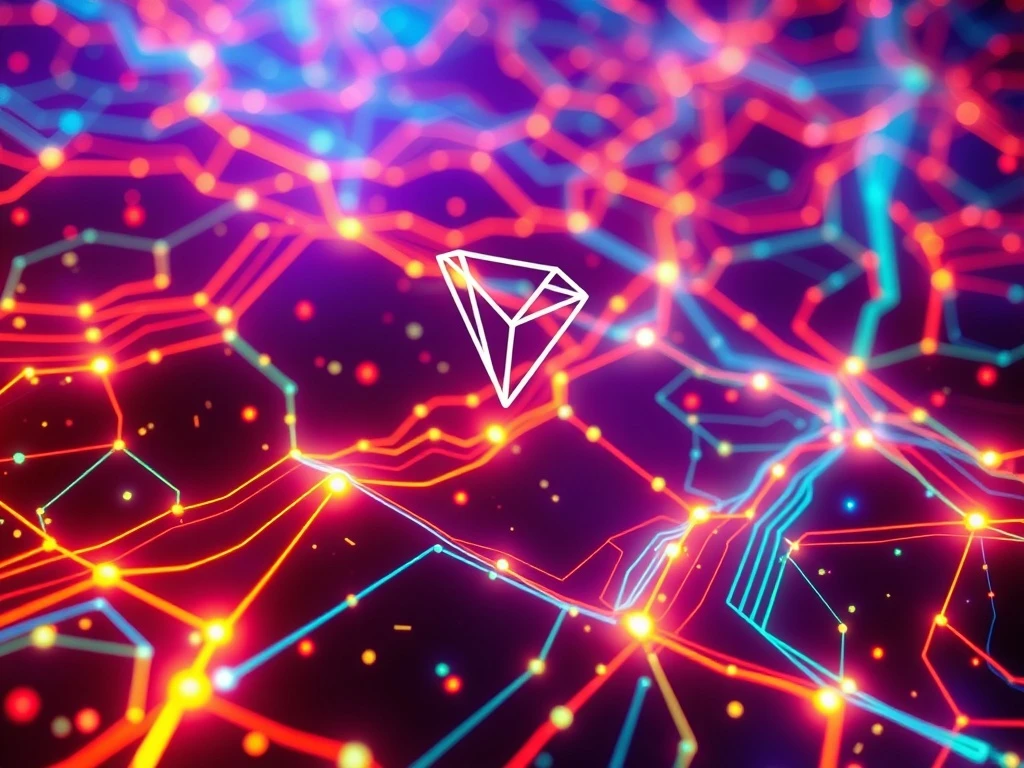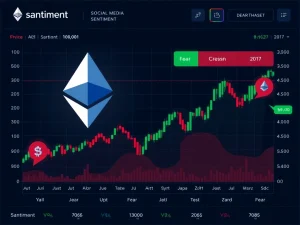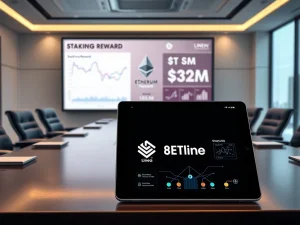Tron Gas-Free: Revolutionizing Blockchain Fees with a Staggering 70% Reduction

Imagine a world where blockchain transactions don’t drain your crypto wallet with exorbitant fees. Tron is making this a reality. The network’s groundbreaking Tron Gas-Free feature has led to a dramatic 70% reduction in average weekly transaction fees, fundamentally altering the landscape of blockchain affordability and access. This isn’t just a minor adjustment; it’s a pivotal shift designed to make crypto more accessible for everyone, from seasoned developers to everyday users.
What Exactly is Tron’s Revolutionary Gas-Free Model?
Tron’s recent implementation of its “Gas-Free” feature marks a significant evolution in how blockchain networks manage transaction costs. Unlike traditional models where users pay a direct fee (gas) for each transaction, Tron has optimized its resource management. Data from Nansen, as cited by Lookonchain on X, clearly illustrates the impact: average weekly transaction fees have plummeted by an impressive 70%, from 2.47 TRX down to just 0.72 TRX since the feature’s rollout in early 2025.
This substantial reduction is achieved through Tron’s innovative Energy and Bandwidth resource framework. Instead of paying direct TRX for every transaction, users can obtain daily quotas of these resources by staking their TRX tokens. Think of it like a daily allowance for your blockchain activities. Once you’ve staked TRX, routine transactions and smart contract executions consume these pre-allocated resources, effectively eliminating the need for direct fee payments in most scenarios. This positions Tron as a highly competitive alternative to networks like Ethereum, where fluctuating and often high gas fees can deter users, especially for micro-transactions or frequent interactions.
How Does TRX Staking Unlock Such Significant Cost Savings?
The core of Tron’s “Gas-Free” model lies in the strategic use of TRX staking. When users stake their TRX, they are essentially locking up a portion of their tokens to contribute to the network’s security and stability. In return, the network allocates them a certain amount of Energy and Bandwidth each day. These resources are consumed when performing actions like:
- Sending TRX or other tokens.
- Interacting with decentralized applications (dApps).
- Executing smart contracts.
- Participating in Decentralized Finance (DeFi) protocols.
For everyday users, the benefits are immediate and tangible. Lower fees facilitate cheaper remittances, enabling individuals to send money globally with minimal friction. It also encourages more frequent dApp engagement and significantly reduces the cost barrier to adopting blockchain technology. For developers, the advantages are equally compelling. Reduced operational costs enable them to build more scalable and sustainable projects. This newfound affordability encourages experimentation with complex smart contracts, fostering innovation in burgeoning sectors like blockchain gaming and decentralized finance.
Is Tron Reshaping Blockchain Fees Across the Industry?
Tron’s success with its reduced blockchain fees could trigger a significant shift across the broader crypto ecosystem. High transaction fees have long been a major hurdle for mass adoption, particularly during periods of network congestion on popular blockchains like Ethereum. Tron’s ability to offer a near “Gas-Free” experience sets a compelling benchmark for affordability and efficiency.
This achievement could exert pressure on other blockchains to adopt similar optimizations, prioritizing user-centric efficiency over traditional, often volatile, gas models. We might see a renewed focus on:
- Innovative resource management systems.
- Enhanced Layer 1 scalability solutions.
- More robust Layer 2 scaling technologies.
- Alternative consensus mechanisms that inherently offer lower costs.
Such developments could reshape the competitive landscape, pushing all networks towards greater accessibility and sustainability. Tron’s model demonstrates that high security and decentralization don’t necessarily have to come at the expense of prohibitive transaction costs.
What Does This Mean for Decentralized Finance (DeFi) Interactions?
The impact of reduced fees on DeFi transactions cannot be overstated. Decentralized Finance, by its nature, often involves multiple on-chain interactions – swapping tokens, providing liquidity, lending, borrowing, and yield farming. Each of these actions typically incurs a transaction fee. When these fees are high, they can make smaller transactions uneconomical and discourage participation from users with limited capital.
With Tron’s “Gas-Free” feature, DeFi becomes significantly more accessible and cost-effective. Users can engage in more frequent trading, explore diverse yield opportunities, and participate in a wider range of DeFi protocols without constantly worrying about gas costs eating into their profits. This encourages greater experimentation and adoption within the Tron DeFi ecosystem, potentially fostering new innovations and attracting a broader user base who were previously priced out of the DeFi space on other networks.
Are There Any Catches to Tron’s Enhanced Crypto Efficiency?
While the “Gas-Free” model presents a significant leap in crypto efficiency, it’s important to understand its nuances and limitations. The term “Gas-Free” can be slightly misleading; it’s not entirely free, but rather shifts the cost model. Users must stake TRX to access the daily Energy and Bandwidth quotas. This requirement can pose a barrier for newcomers who do not yet hold TRX tokens, as they would need to acquire and stake them to benefit from the feature.
Additionally, while routine transactions are covered, extreme network congestion could temporarily deplete free resources, necessitating small TRX payments for urgent transactions. This is a rare occurrence but a possibility to be aware of. Critics also frequently point to Tron’s Delegated Proof-of-Stake (DPoS) consensus mechanism, which relies on a limited number of validators (Super Representatives), as a potential centralization risk. It’s crucial to note that this is a structural aspect of Tron’s network and largely unrelated to its fee structure, but it remains a point of discussion within the broader crypto community.
Maximizing Your Tron Experience: Actionable Insights
- For Users: To fully leverage the “Gas-Free” benefits, it is advisable to stake a sufficient amount of TRX to secure your daily Energy and Bandwidth quotas. This ensures seamless and cost-effective transactions for your everyday blockchain activities.
- For Developers: Optimize your smart contracts to be resource-efficient. Additionally, exploring potential fee subsidies or resource grants from the Tron ecosystem can further enhance user adoption and reduce the operational burden for your dApps.
Despite lingering concerns about centralization and the initial staking requirement, the overwhelming 70% fee reduction underscores Tron’s strategic focus on accessibility and user experience. This move aligns with broader industry trends toward scalable, cost-effective blockchain solutions, solidifying Tron’s position as a formidable player in the decentralized landscape.
Frequently Asked Questions (FAQs)
1. What does Tron’s “Gas-Free” feature mean?
Tron’s “Gas-Free” feature means that users do not directly pay a transaction fee (gas) in TRX for most routine operations. Instead, by staking TRX, users receive daily quotas of Energy and Bandwidth resources, which are consumed during transactions, effectively making them free of direct payment.
2. How much have Tron’s transaction fees decreased?
Since the implementation of the “Gas-Free” feature in early 2025, Tron’s average weekly transaction fees have plummeted by 70%, dropping from 2.47 TRX to just 0.72 TRX.
3. Do I need to pay anything for “Gas-Free” transactions on Tron?
While you don’t pay a direct fee per transaction, you need to stake TRX tokens to receive the necessary Energy and Bandwidth resources. If you don’t have enough staked TRX or if network congestion is high, you might still need to pay a small amount of TRX for urgent transactions.
4. What are the benefits of this feature for users and developers?
For users, benefits include cheaper remittances, more frequent dApp engagement, and reduced friction in blockchain adoption. For developers, it means lower operational costs, enabling more scalable and sustainable projects, and encouraging experimentation with complex smart contracts.
5. Are there any downsides or challenges to Tron’s “Gas-Free” model?
Challenges include the requirement to stake TRX, which can be a barrier for newcomers, and the possibility of temporary fees during extreme network congestion. Additionally, some critics point to Tron’s DPoS consensus mechanism as a potential centralization risk, though this is unrelated to the fee structure itself.
6. How does Tron’s fee model compare to Ethereum’s?
Tron’s “Gas-Free” model, based on resource allocation via staking, offers significantly lower and more predictable transaction costs compared to Ethereum’s traditional gas model. Ethereum’s gas fees can be highly volatile and expensive, especially during peak network usage, making micro-transactions often impractical.








